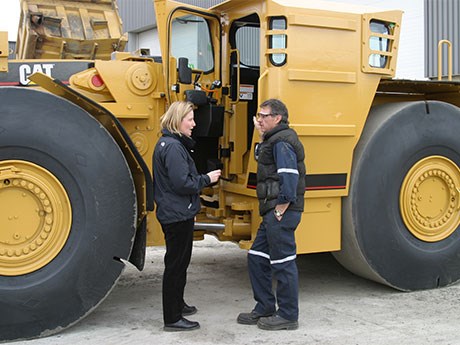Centre for Research in Occupational Safety and Health studies collision avoidance, impact on reproductive health
The Centre for Research in Occupational Safety and Health (CROSH) at Laurentian University has received funding of $1million from the Northern Ontario Heritage Fund for the establishment of a research chair in occupational health and safety.
The new research chair will lead research activities for the centre and work towards creating CROSH as a national and international leader in occupational health and safety research, development, education, training and global best practices.
CROSH provides a formalized structure for industry, safe workplace associations, labour groups, government organizations and researchers to share workplace injury and disease problems and solutions.
“Our research members are from all over the university – medicine, nursing, computer science, human kinetics, sociology, social work and labour studies,” said CROSH director Dr. Tammy Eger.
Collision avoidance
CROSH is working on a project in collaboration with Xstrata Nickel and camera manufacturer PROVIX to investigate the use of collision avoidance systems on underground mining equipment. They identified ways to add an optimal secondary navigation aid to provide a nearly 360-degree view around underground machinery, which normally has extremely limited line-of-sight.
“A number of accidents have occurred and there have been some fatalities with large machinery, which has the industry in need of looking at a solution for line of sight on mobile equipment,” said Eger.
The research will measure a number of factors related to cameras that provide a 360-degree view around the machinery. A lab-based study using a quantitative electroencephalograph and eye tracker will monitor the level of activity in different regions of the brain when an operator is using the cameras to navigate.
PROVIX has been developing camera systems since the ’80s, mostly for emergency and recreational vehicles. The company became involved with CROSH after attending a mining safety conference to establish partnerships in the mining sector.
“Working with CROSH is a natural collaboration,” said Dave Winfield, manager, PROVIX. “Dr. Eger provides scientific validation to what is practical.”
Winfield said they adjusted the design of the cameras to use a different lens angle, changed the positioning of the cameras and switched to double monitors rather than single monitors in the cab so they are ergonomically positioned. The system has also been programmed for remote operation through a wireless video transmission to a safe operator station.
The research was conducted on load-haul-dump equipment at Xstrata’s Kidd Creek Mine in Timmins. As a result of the research, the company has installed collision avoidance equipment on all of its loaders and haul trucks.
Winfield says he has more companies approaching him to look at the camera system for their equipment and CROSH is currently testing the collision avoidance system on Vale equipment.
CROSH researcher Dr. Sandra Dorman produced a booklet to help educate pregnant women working in mines.
“We are having more honest conversations about the concerns people have and conducting research on those concerns,” said Eger. “CROSH holds regular community symposiums to help identify research needs and share our findings. One of the concerns that came forward was reproductive health hazards in mining. Our response to this concern was to develop a guide for women pregnant and breast feeding who are working in the mines.”
CROSH researchers conducted an extensive literature review and identified risk factors based on evidence-based research. The guides are bilingual and also available on its website.
“The guide to healthy pregnancies broke down the research results into lay language for workers and their families about the potential physical and chemical hazards, impact on the potential for getting pregnant, and if pregnant, what risk there was to the fetus and while breast feeding. There are also a set of recommendations to avoid risk,” noted Eger.
A second guide is being developed in response to men asking for more information about the reproductive health hazards for them. A guide is currently being worked on and is due to be published in the coming year.
Other research projects include the prevention of and therapy for vibration induced injury. CROSH hopes to link workplace exposure to clinical evidence of vibration induced white foot. It will also investigate the use of stem cell therapy as a potential option for treatment.
A workplace mental health and cognitive factors research project will investigate the impact of sleep quality and adverse health consequences for shift workers.
With the establishment of a research chair, CROSH looks forward to attracting larger research grants and recruiting more students with energy and passion to carry out the fieldwork. By 2014, it will identify three high-priority research areas and hold, minimally, two community forums a year to discuss local issues and priorities, and share research findings.
Twitter: @CROSH_CRSST



